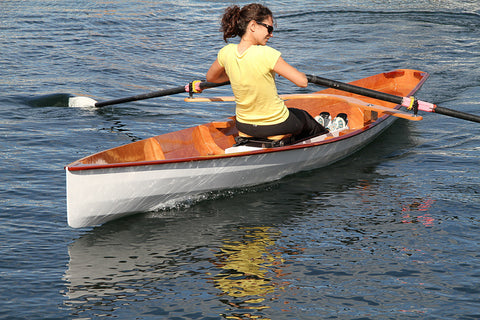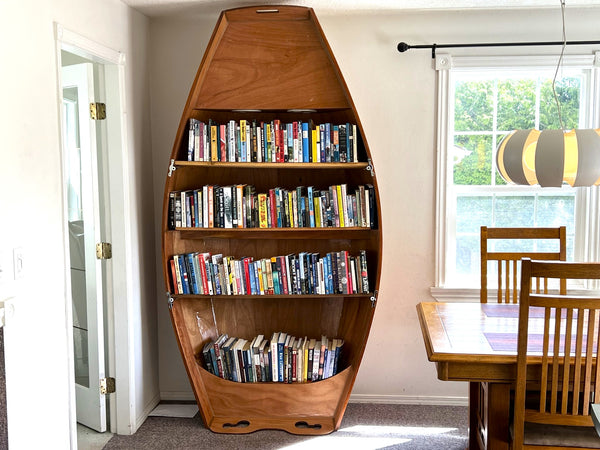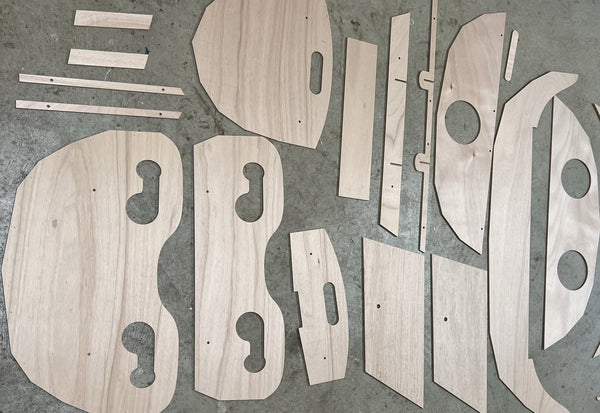Everything You Need to Know About Sculling Oars
There’s plenty of information outlining the benefits of a sliding seat rowing system for recreation, but there is very little information about the oars required. For newcomers to the sport, it can be confusing figuring out what is needed. We decided it was time to write a comprehensive page outlining everything you need to know about sculling oars.
Overview
Many people purchase a sliding seat system for their boat believing they can use it with a standard set of wooden oars. Unfortunately, this is not the case, and it can be a little discouraging finding out what a proper set of sculling oars will cost. Fiberglass/carbon oars will generally set you back $500-$700 for a pair.
discouraging finding out what a proper set of sculling oars will cost. Fiberglass/carbon oars will generally set you back $500-$700 for a pair. Oars for a sliding seat rowing system (sculling oars) need to be much longer than standard oars used for fixed seat rowing. As a result they require lighter and more expensive construction techniques. Additionally, the shaft requires special shaping or shaped sleeves to allow proper feathering action within the oarlock. You may be tempted to put up with a less-than-ideal setup, simply using oars from your local marine store, but it isn’t worth it. The performance will be so poor, you’re better off using a fixed-seat rowing rig at less expense. If you’re planning on using a sliding seat system for your boat, be sure to factor in the cost of proper rowing sculls. Alternatively, economical and attractive wooden sculling oars can be constructed if you have the time.
Oar Specs
 Generally sculling oars are 9’ 6” in length, and construction is as light as possible. Carbon fiber oars weigh about 3.5 lbs each while fiberglass and hollow shaft wood are about 4-5 lbs.
Generally sculling oars are 9’ 6” in length, and construction is as light as possible. Carbon fiber oars weigh about 3.5 lbs each while fiberglass and hollow shaft wood are about 4-5 lbs.
There are two main blade shapes – Macon and Hatchet (also known as cleaver). Macons are the traditional tulip-like shape and the oars are symmetrical on both sides), while Hatchets are asymmetrical with more blade extending down from the shaft into the water. Hatchets are either port or starboard. Both designs work well, however, hatchets are slightly more efficient. Macons on the other hand, are more effective if you decide to row without feathering since the blades are less likely to catch the water on the return stroke.
Oar Feathering
Unlike fixed seat rowing, it is important that sculling oars are feathered (turned horizontal to the water) on the return stroke. This is not just for decreasing wind resistance, but it reduces the chance of the blades catching the water, since there is generally less clearance than with a fixed seat system.
 Those who have tried feathering oars in a fixed seat rig, will find that it is very different than a sliding seat system. Fixed rig oar shafts are generally round meaning it is a very imprecise action, and angle varies slightly with each stroke. Additionally, friction between the oarlock and the oar is often significant, making it a chore with time. With sculling oars and oarlocks, however, the two have been precisely shaped and engineered to facilitate easy precise feathering. In each position (feathered and stroke) the shaft or oar sleeve of the sculling oar has flat edges which are braced against the flat edges of the oarlock. This allows the oar blade to maintain a precise angle through each stroke (see image to the right).
Those who have tried feathering oars in a fixed seat rig, will find that it is very different than a sliding seat system. Fixed rig oar shafts are generally round meaning it is a very imprecise action, and angle varies slightly with each stroke. Additionally, friction between the oarlock and the oar is often significant, making it a chore with time. With sculling oars and oarlocks, however, the two have been precisely shaped and engineered to facilitate easy precise feathering. In each position (feathered and stroke) the shaft or oar sleeve of the sculling oar has flat edges which are braced against the flat edges of the oarlock. This allows the oar blade to maintain a precise angle through each stroke (see image to the right).
 The image illustrates how the oar shaft is stable in the feathered and drive position. The oarlock is shaped so the blade is angled at about seven degrees off of horizontal on the return/feathered stroke. This slight angle reduces the chance of the oar catching if it hits the water, instead it will skip like a flat rock. In the drive/vertical position, the shaft is positioned so it is about 3 degrees off vertical, which is the ideal angle for the drive stroke. The overall angle of the oarlock can also be adjusted slightly (racers sometimes prefer to have less angle) with special bushings. The transition from one position to the other is achieved very easily with a gentle twist of the wrist.
The image illustrates how the oar shaft is stable in the feathered and drive position. The oarlock is shaped so the blade is angled at about seven degrees off of horizontal on the return/feathered stroke. This slight angle reduces the chance of the oar catching if it hits the water, instead it will skip like a flat rock. In the drive/vertical position, the shaft is positioned so it is about 3 degrees off vertical, which is the ideal angle for the drive stroke. The overall angle of the oarlock can also be adjusted slightly (racers sometimes prefer to have less angle) with special bushings. The transition from one position to the other is achieved very easily with a gentle twist of the wrist.
Having the flat edge of the shaft abutting the flat edge of the oarlock not only provides a stable defined angle, but it also helps distribute the pressure across the shaft. A round oar shaft (only used in fixed seat rowing) generally has a very small contact point with the oarlock which increases the chances of it breaking and causing excessive wear. As you can see in the image (right) of a typical fixed seat oarlock system, the contact point between the shaft and oarlock is minimal, and blade angle is ambiguous with regards to shaft orientation in oarlock.
Oar Sleeves and Buttons
 When the original sculling oars were made from wood (hollow shaft), the shafts were not round, but were shaped to the same cross-profile as to what is shown above in the oarlocks. This meant the shaft only required a “button” which is a collar-like fitting that kept it from slipping through the oarlock. Usually, a leather wrap was also applied to reduce wear. Wooden oars now often use a wrap of fiberglass to protect from wear and reduce friction.
When the original sculling oars were made from wood (hollow shaft), the shafts were not round, but were shaped to the same cross-profile as to what is shown above in the oarlocks. This meant the shaft only required a “button” which is a collar-like fitting that kept it from slipping through the oarlock. Usually, a leather wrap was also applied to reduce wear. Wooden oars now often use a wrap of fiberglass to protect from wear and reduce friction.
With the advent of carbon fiber and fiberglass oars, it was easier and stronger to manufacture oars with round shafts. This meant that at the location of the oarlock, is was necessary to install a sleeve (see image to right) that replicates the shape of traditional oar shaft for proper action in the oarlock.
Properly designed and shaped wooden sculling oars do not require sleeves since the oar shaft is already the correct shape for ideal feathering action.
Oarlocks
 Since the action between the oar shaft and oarlock is very exact, there is only one basic shape of sculling oarlock which is the same regardless of manufacturer. Generally, the oarlocks utilize a gate system which keeps the oars securely in place, and, more importantly, strengthens the oarlocks by providing support across the top. There are a few open designs, however, these are not as strong. Do not use oarlocks designed for a fixed seat system in a sliding seat rig.
Since the action between the oar shaft and oarlock is very exact, there is only one basic shape of sculling oarlock which is the same regardless of manufacturer. Generally, the oarlocks utilize a gate system which keeps the oars securely in place, and, more importantly, strengthens the oarlocks by providing support across the top. There are a few open designs, however, these are not as strong. Do not use oarlocks designed for a fixed seat system in a sliding seat rig.
Hollow Shaft Wooden Oars
An alternative to expensive carbon/fiberglass oars is constructing your own wooden sculling oars. These should not be confused with regular wooden oars, as there is a world of difference in weight, shape and specs. The shaft should be hollow to reduce weight, and it should not be round. Sculling oars are made from lightweight strong woods such as spruce. Generally, construction costs range from $50-$200. We sell plans in our online store for hollow shaft oars. Click here for more information. There are also a few manufacturers in the U.K. that produce completed wooden oars, however, costs, including shipping to North America are over $1000/pair.
Two-Part Oars
Sculling oars are approximately 9.5' in length. While this is ideal for rowing, they immediately become unwieldy for transporting or storing. A solution for this is to use two-part oars that break in half with a ferrule. Advanced manufacturing techniques now allow this option with minimum weight penalty. If the budget allows, two part oars will make life much easier on and off the water.
Where to Purchase Sculling Oars?
There are a number of companies in North America (including our own) offering good quality sculling oars, and we list them below. When comparing pricing, be sure to include shipping costs, as one-part oars are subject to extreme oversize penalties.
One-Part Sculling Oars:
Two-Part Sculling Oars
- Duckworks
- Whitehall
- Red Beard Sailing
- Angus Rowboats (our company)
Rowing Geometry
For information on positioning of the oarlocks, sliding seat, foot braces, etc, please visit our rowing geometry page.
8 Responses
Andre
Having built the Oxford Wherry, I am looking for a set of Sculling oars. The length required is 9’ 6”. If anyone has a used set please send me a note. Ideally a Concept2 set would be preferred.
Paul Correll
Please let me know where to purchase buttons for the leather wrapped hollow oars that we have constructed from your design.
Thanks,
Paul
Rod
Hi Colin,
I’m interested in both your sliding seat and rigger system and the wooden oars.
Can you tell me what wood I’ll need (type and dimensions) to build these?
If the wood is not available locally (Ohio), can you recommend an internet soruce?
Thanks,
Rod
admin
Ideally, you’ll be using clear sitka spruce in ten foot lengths. Good pine can also be used. Heavier woods such as fir are good for strength, but will make the oar heavier.
admin
We will have buttons available in our online store next month.
Randy
Your entire story and website are fantastic and very inspiring. I keep going back to the build gallery, your oars are beautiful. I built 2 pair of oars and I was pretty proud of them but now after seeing yours its time for an evolution. https://www.youtube.com/watch?v=OqDjFy8z08U Thank you
My oars do work and got me on the water and hopefully have inspired some backyard builders to go for it.
Thanks again
Bob Cramer
I have a pair of new 9’6" Piantedosi sculling oars for sale. Not sure what they are worth – will sell for best offer.
Bob Cramer
Guy S.
@ Bob Cramer – if you still have those wood oars I would be interested in them.
Please email me: 521sharktown@gmail.com
Thanks,
Guy S.
Leave a comment
Comments will be approved before showing up.
Also in News

Human Powered Achievements through the Northwest Passage
At Angus Rowboats, our passion for adventure naturally draws us to the mystique of the Northwest Passage – one of the world's most captivating and perilous waterways. Historically, this elusive passage promised a shorter shipping route, spurring early navigators to fervently chart and struggle through its icy intricacies.
The summer of 2023 saw three audacious teams, including one using our very own RowCruiser boats, aiming to be the first to traverse NW Passage solely by human power within a single season. As the season concludes, we've chronicled these attempts, and catalogued past human-powered endeavors to navigate the Northwest Passage.

Creating a Bookcase from a Boat


Angus Rowboats
Author